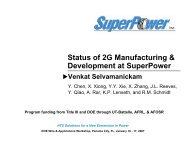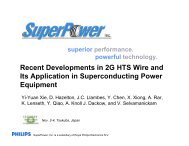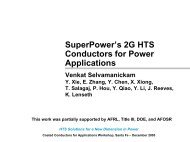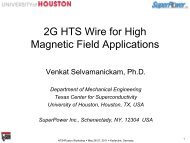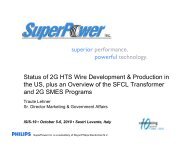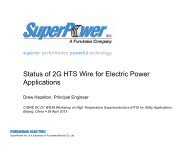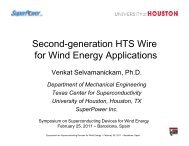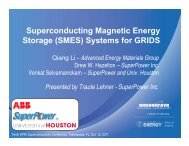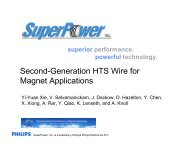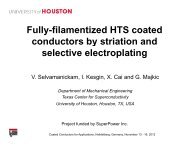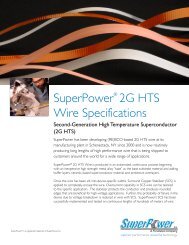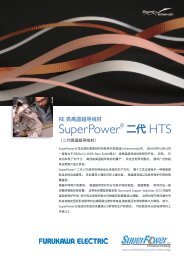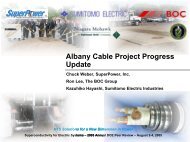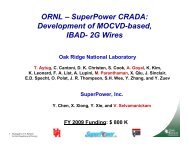New York State Leaders In Superconductivity... - SuperPower
New York State Leaders In Superconductivity... - SuperPower
New York State Leaders In Superconductivity... - SuperPower
Create successful ePaper yourself
Turn your PDF publications into a flip-book with our unique Google optimized e-Paper software.
11. Mark Ketchen (IBM, Poughkeepsie) ~ Dr. Ketchen has been a pioneer in superconducting electronics from the early years<br />
of IBM’s involvement in the 1970s and 1980s. He has invented and implemented a number of innovative SQUID circuits and<br />
designs, many of which formed the basis of all SQUID applications today. Dr. Ketchen led many of the IBM efforts in advanced<br />
microcircuit design and fabrication and is a tireless advocate of superconductivity at IBM, in the state of NY, in the US and<br />
worldwide. He has won numerous awards and is recognized by his peers as one of the statesmen in the field. Dr. Ketchen is poised<br />
to play a leading role in any expected revival of superconducting electronics for high performance and high efficiency computing.<br />
12. Evangelos Trifon Laskaris (GE Global Research, Niskayuna) ~ Dr. Laskaris has had a long and impactful career in<br />
superconductivity. He has been a key inventor in almost every MRI magnet that GE has developed. He holds the largest number<br />
of patents of any researcher at GE Global Research and was named a member of the National Academy of Engineering in 2004<br />
for his pioneering contributions to the design and construction of superconducting magnets for MRI systems. He has taught and<br />
mentored many people in superconductivity over his long and continuing career at GE.<br />
13. Qiang Li (Brookhaven National Laboratory, Upton) ~ For a superconductor, charges need to be paired and moving coherently<br />
to carry a current with no resistance. The ‘stripe’ order suggests the charges are localized in relatively fixed positions. Brookhaven<br />
studies suggest that the presence of alternating stripes of magnetism and charge exist in other superconducting materials, in a way<br />
that is more fluid and therefore harder to detect. One of the key measurements, made by Brookhaven physicist Dr. Qiang Li, was<br />
of electrical resistance parallel to the planes of the layered material and also perpendicular to them. At a particular temperature,<br />
Li detected a big drop in resistance when the current was flowing parallel to the layers, but not when it was flowing perpendicular<br />
to them. More broadly, Li currently leads the Advanced Energy Materials Group in the Condensed Matter Physics and Materials<br />
Science Department that studies the microscopic and macroscopic properties of complex and nano-structured materials, including<br />
new superconductors, with a view to understanding and developing their application in different and real-world energy related<br />
technologies. Dr. Li is part of the BNL team that recently received a grant from the U.S. DOE’s Advanced Research Projects<br />
Agency-Energy (ARPA-E) to fund superconducting magnet energy storage research.<br />
14. Garry Morrow (<strong>In</strong>termagnetics General Corporation, Latham) ~ During his nearly 30-year tenure with <strong>In</strong>termagnetics,<br />
Mr. Morrow was instrumental in the development and marketing of very-high field Nb3Sn magnets (1970s), work on the first<br />
superconducting MRI magnets including actively-shielded and mobile MRI (1980s) and commercialization of MRI technology.<br />
Garry actively pursued new applications of superconductivity and was Vice President the MagStream division of IGC which<br />
involved utilizing superconductivity for magnetic separation of materials.<br />
15. Carl H. Rosner (GE, Schenectady; <strong>In</strong>termagnetics, Latham; CardioMag Imaging, Schenectady) ~ Mr. Rosner co-founded<br />
<strong>In</strong>termagnetics General Corporation (Guilderland and Latham, NY) in 1971, prior to which he was Manager of General Electric’s<br />
Superconductivie Products Operation in Schenectady. During his tenure with IGC, he led the company’s growth to more than 250<br />
employees and to the successful development of a number of applications of superconductivity, most notably superconducting<br />
magnets for MRI. Until 1999 he held the roles of Chairman, President and CEO of <strong>In</strong>termagnetics. That company was acquired by<br />
Philips in 2006. He retired from IGC as Chairman-Emeritus in 2002 to devote his full time to building and developing CardioMag<br />
Imaging. Mr. Rosner is a graduate of the Stockholm <strong>In</strong>stitute of Technology, <strong>New</strong>ark College of Engineering and Rensselaer<br />
Polytechnic <strong>In</strong>stitute with undergraduate and graduate degrees in electrical engineering and business management. He is a<br />
member of the National Academy of Engineering and is the author and co-author of many published papers on superconductive<br />
and electronic devices. He holds seven patents.<br />
16. William Sampson (Brookhaven National Laboratory, Upton) ~ A physicist in the Superconducting Magnet Division at BNL,<br />
Dr. Sampson has helped to design and build superconducting magnets that keep particle beams circulating in accelerators, such as<br />
Brookhaven’s Relativistic Heavy Ion Collider (RHIC). <strong>In</strong> the 1960s, he built some of the first superconducting magnets to exceed<br />
10 Tesla, 200,000 times the earth’s magnetic field. Sampson also made early models of dipole and quadrupole magnets, used for<br />
bending and focusing beams of particles in accelerators. Accelerators around the world, including RHIC and the Large Hadron<br />
Collider (LHC) at CERN, have benefited from this pioneering work. <strong>In</strong> the 1970s, Sampson made magnets called “wigglers”<br />
for the National Synchrotron Light Source, which began operating in 1982. Sampson has also worked on HTS magnets that can<br />
operate in high radiation environments. Currently, Sampson is developing very high-field superconducting magnets that may be<br />
used in building a high-energy muon collider. He has received the IEEE Council on <strong>Superconductivity</strong> Award for Significant and<br />
Sustained Contributions in the Field of Applied <strong>Superconductivity</strong>, in particular, for his contributions to the field of large-scale<br />
superconductivity<br />
~ 33 ~



